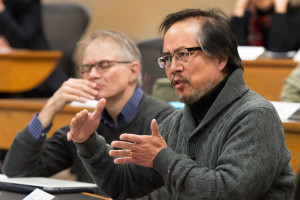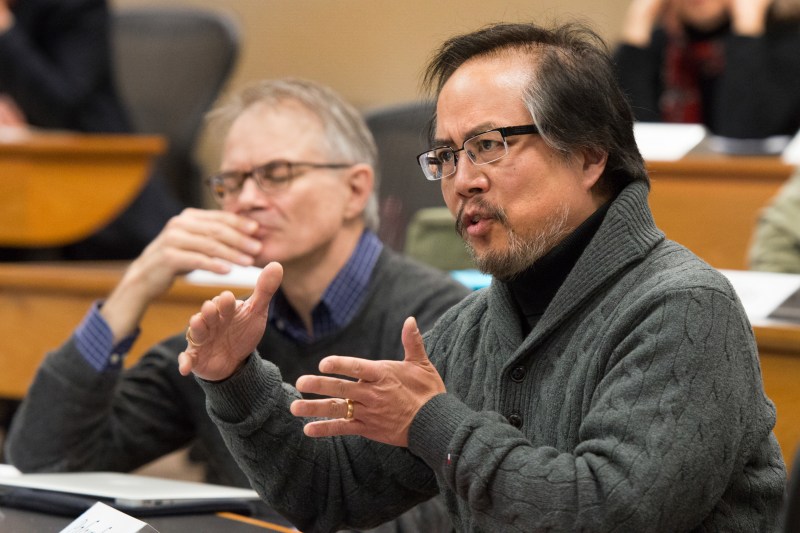The Faculty Senate heard reports on the impact of potential federal budget cuts on research at Stanford at its Thursday meeting.
Senate Chair Raymond Levitt, professor of civil and environmental engineering, opened the meeting by applauding the election of Susanna Loeb ’88, professor of education, to the National Academy of Education and the selection of two Stanford graduates as Gates Cambridge Scholars.

Peter Michelson M.S. ’76 Ph.D. ’80, professor of physics and chair of the Academic Council’s Committee on Research, opened the meeting’s agenda by providing the Senate with some background information on the potential cuts in federal research spending.
According to Michelson, federal funding constitutes 17 percent of Stanford’s total consolidated revenues and supports 80 percent of all research conducted at the University outside of the SLAC National Accelerator Laboratory. Under existing legislation, a failure by Congress to agree to sufficiently large deficit reduction measures by March 1 will prompt substantial cuts to all discretionary spending, including Stanford’s extensive research funding.
Ryan Adesnik, director of federal relations, emphasized the difficulty of making a case for protecting federal research funding to a Congress fixated on fiscal responsibility.
“Every piece of legislation that comes to the floor of Congress is viewed” in terms of costs and deficits incurred, Adesnik said. “There are no more free rides.”
Adesnik expressed doubt that Congress would avert the sequester– and the corresponding spending cuts– by March 1. He offered a more optimistic view, however, of the likelihood of Congress averting a March 27 government shutdown by making temporary and incremental budgetary adjustments.
“It’s unlikely [that], in the next week, you’re going to get a deal,” Adesnik said.
While the sequester cuts will likely apply to all eligible programs equally, Adesnik noted that research funding might be protected from the worst of the cuts. Over the last three years, the amount of funding offered by research agencies like the National Institutes of Health has remained relatively constant or even grown while associated departments have cut overall spending.
“Science accounts are outperforming the rest of the accounts in the budget,” Adesnik said. “This is happening in a bipartisan way.”
Reviewing the long-term future of federal research funding, Adesnik struck a largely cautious tone.
“Deficit reduction is here to stay,” Adesnik acknowledged. “[However], we’re going to get continued strong support for scientific research<\p>…<\p>We’ve really won the argument that we’re a priority.
“We’re going to keep advocating hard for getting these things [funding levels] back to where they should be,” he added.
Dean of Research Ann Arvin opened her presentation by emphasizing the diminishing relative significance of research funding to University operations, even as research funds received grow in absolute value.
Arvin noted that the projected sequester cut of eight percent would reduce the University’s projected research revenues of $685 million in 2013 by just $51 million, out of a $4.5 billion total for the University as a whole. Moreover, from 1998 to 2011, the proportion of research supported by external grants fell from 40 to 28 percent.
Arvin acknowledged, however, the potential for funding cuts to be more acutely felt in certain areas of the University compared to others, citing as an example the prominent role played by research funding in supporting graduate students in non-medical fields.
Faculty discussion and questioning focused largely on the manner in which cuts might be implemented as well as on the University’s ability to mitigate the cuts’ impact.
Glenn Chertow, professor of medicine, voiced his concern that funding reductions may come at the expense of School of Medicine students, whose clinical teaching presents faculty members with a significant time commitment and no immediate fiscal upside.
“My concern is that the first casualties will be the students,” Chertow emphasized.
While some faculty members expressed concern about statements made by House Majority Leader Eric Cantor that argued for even more extensive cuts in research funding, Adesnik dismissed this rhetoric as political posturing. After being reminded by Levitt that Faculty Senate transcripts are available to the public, however, Adesnik quickly reversed course.
“Eric Cantor’s a great American,” Adesnik jestingly clarified.
Arvin concluded the meeting by offering the Senate a preview of online resources currently under development that aim to consolidate relevant information about obtaining research grants for faculty consumption.
The Senate will hear the annual reports of Vice Provost for Graduate Education Patricia Gumport M.A. ’82 M.A. ’86 Ph.D. ’87 and Dean of the Graduate School of Education Claude Steele at its next meeting on March 7.
